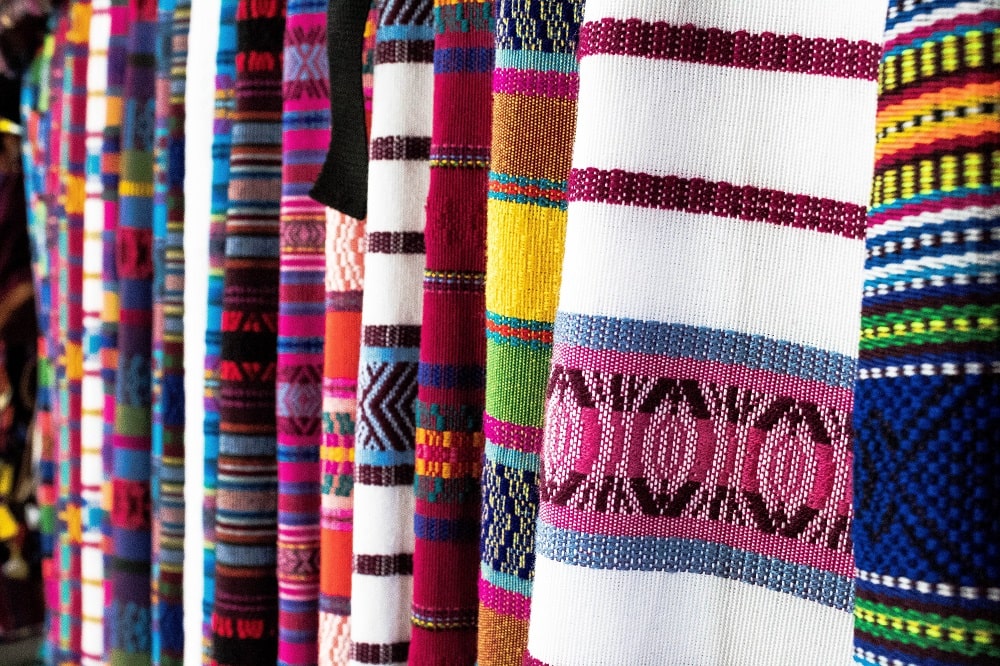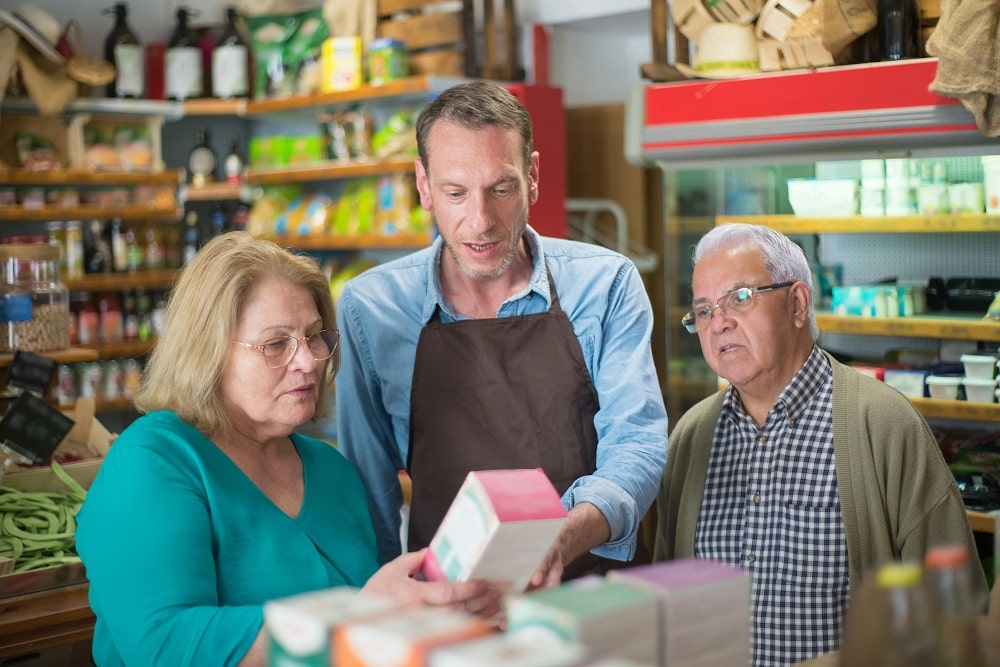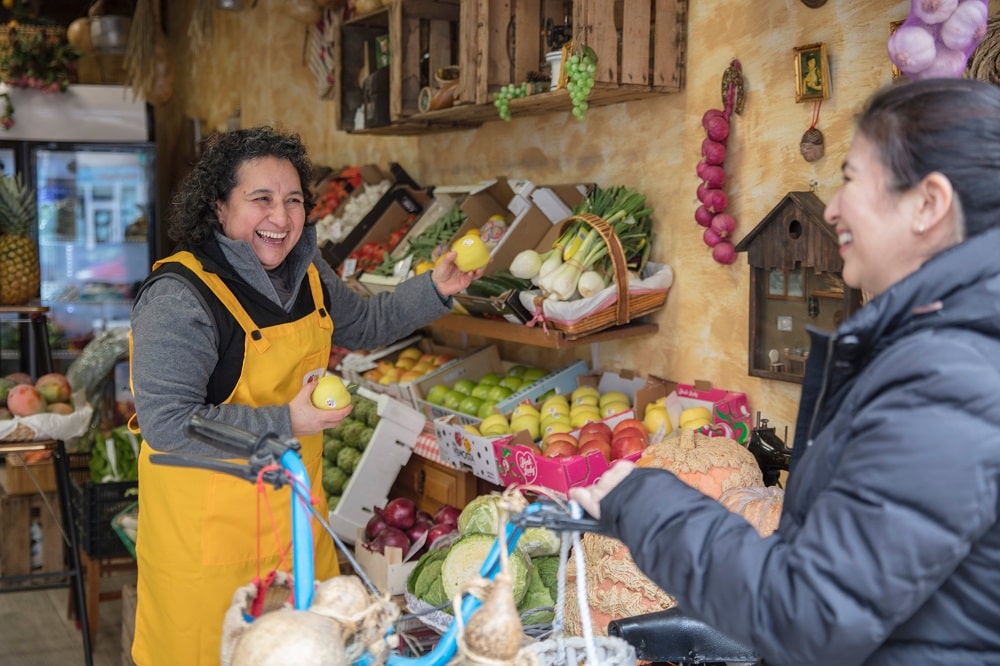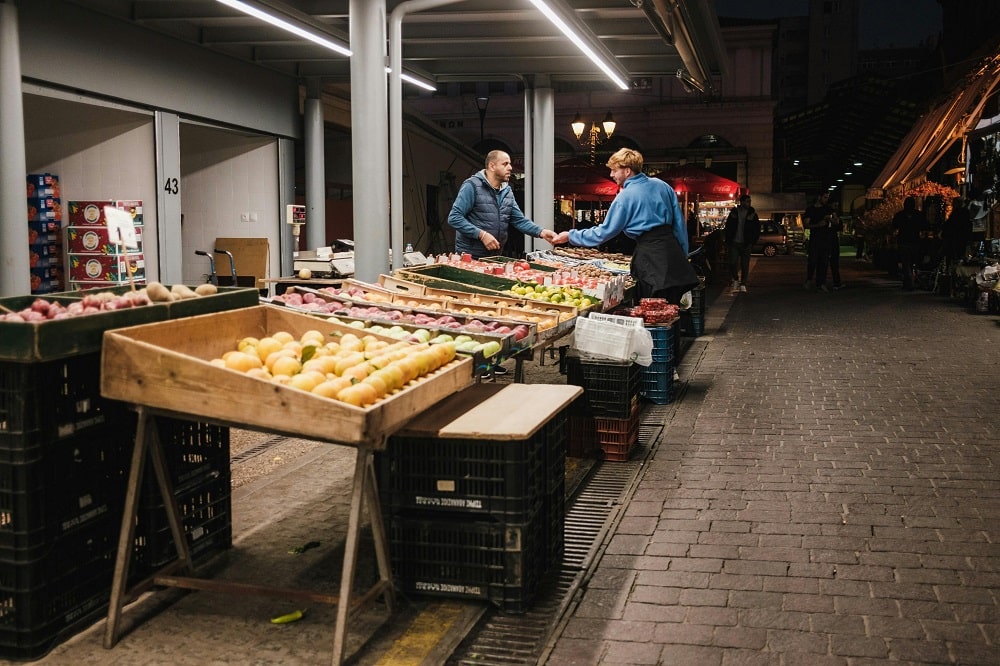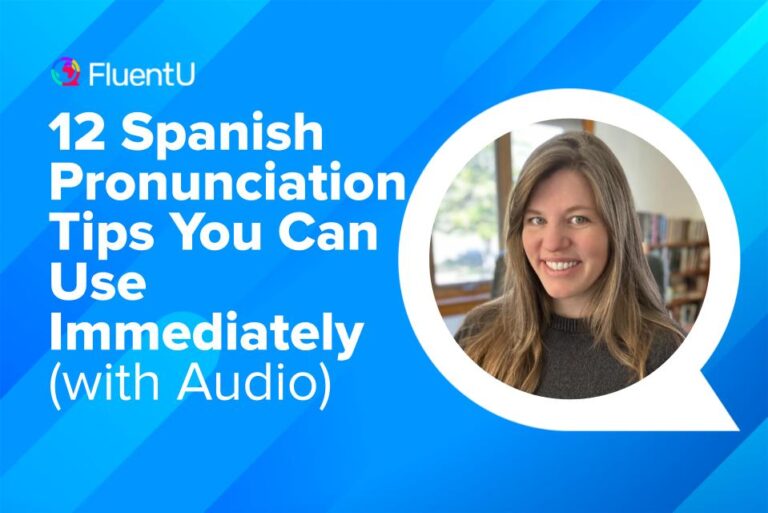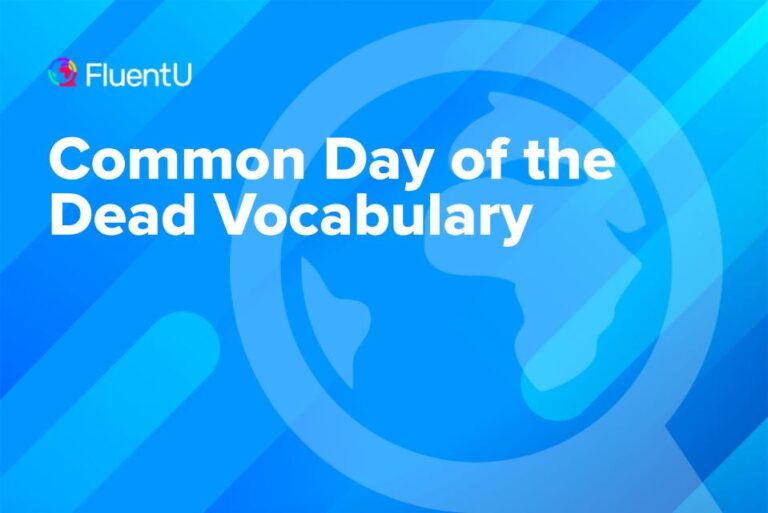Common Spanish Shopping Vocabulary

What you want, the Spanish-speaking world has got it. But money won’t get you everything you’ve been dreaming of—you need the right words and phrases to get you to the right shops (and to get you the right prices), such as mercado (market) and ¿Cuánto cuesta? (How much is it?).
Until you learn how to shop in Spanish like the locals do, you may find yourself getting treated (and priced) as a tourist, so read on to find out more. You can also have a look at this story-based lesson from our YouTube channel:
Download: This blog post is available as a convenient and portable PDF that you can take anywhere. Click here to get a copy. (Download)
Ir de compras — Going shopping
Ready to go shopping in Spanish? Let’s begin!
- entrada — entrance
- salida — exit
- horario de atención — business hours
- abierto — open
- cerrado
— closed
You might notice a sign saying something like cerrado al mediodía (closed at noon). They may not mean exactly at noon, but the idea is that the store will be shut down for a lunch hour. - feriado (Latin America), festivo (Spain) / puente — holiday/long weekend
And just so you don’t make a fool of yourself by angrily forcing the doors in the wrong direction:
Las tiendas — The shops
Need to know where to buy things? You’ll need to ask for the right type of store.
- local — storefront
- tienda — shop/store
- tiendita — literally “little shop,” usually means “convenience store”
- boutique — boutique
- almacén — storehouse, large shopping depot
- mercado — market
- supermercado — supermarket
- mercado artesanal
/ feria artesanal
— artisanal market
This is going to be the place for souvenirs ( recuerdos ) that have been handcrafted ( hechos a mano ). - ferretería — hardware store
- centro comercial — mall
- centro de compras — shopping center
- agencia de viajes — travel agency
- cafetería — café, buffet, snack bar
- carnicería — butcher
- licorería — liquor store
- panadería — bakery
- pastelería — pastry/cake shop
- frutería — fruit shop
- pescadería — fish stand
- peluquería — hair salon
- farmacia — pharmacy
- floristería / florería — flower shop
- gasolinera
— gas station
Store this word in your brain while traveling Latin America, as this is often a good place to go for bathrooms, ATMs and making change for large bills. - joyería — jewelry store
- juguetería — toy store
- librería
— book store
This false friend sounds like “library,” but a library is actually a biblioteca - papelería — paper/office supply store
- tienda de ropa — clothing store
- tienda de deportes — sports store
- tienda de música — music store
- zapatería — shoe store
¿Dónde comprar? — Where to buy?
If you only know what you want to buy, but you don’t know where it might be, ask either of the following questions:
- ¿Conoce un lugar donde realizan … ? — Do you know a place where they make/do/perform … ?
- ¿Conoce un lugar donde venden … ? — Do you know where they sell … ?
Now, if you want some local opinions to factor into your decision-making, strike up a conversation with somebody and ask:
- ¿Conoce algún … por aquí cerca? — Do you know of a … around here?
You can even get more specific and explain what kinds of qualities you hope for this place to have, using a question like:
- ¿Dónde queda la tienda de ropa más (cercana / económica / chévere)? — Where is the (closest/cheapest/coolest) clothing store?
All you have to do is insert another kind of store aside from tienda de ropa and you’ll be ready to ask about anything.
When you’re faced with a couple of good options but don’t know which one might be best, ask somebody:
- ¿Cuál me recomienda? — Which one do you recommend to me?
Cositas — Little things
You’re going to want to be able to say all kinds of things. If you’re looking for food and restaurant vocabulary, we’ve already got you covered. Soccer equipment? Covered. Here, I’ll explore artisanal and textile items, since this is a lot of what you’ll encounter at street markets.
- artesanías — artisanal goods/crafts
- artesano / artesana — craftsman / craftswoman
- proyecto comunitario
— community project
Crafting artisanal goods is often a community endeavor, so you’ll want to ask about who’s behind the items you’re buying. Always support local endeavors when possible! - cooperativa
— cooperative
This is a good term to hear in the artisanal market, as goods crafted, distributed and sold by a cooperativa are benefiting a community group. Community cooperatives are required to receive Fair Trade certification. - Comercio Justo — Fair Trade
- orgánico — organic
- del monte / del bosque / de la montaña — from the hills / from the forest / from the mountains
- de la selva / jungla — from the jungle
- del mar / de la playa — from the sea / from the beach
- todo natural — all natural
- hecho a mano / hecha a mano — handmade
- casero / casera — homemade
- tallado / tallada — carved
- cosido / cosida — sewn
- tejido / tejida — knitted
- cerámica — ceramic
- porcelana — porcelain
- fibras — fibers
- diente de tiburón / de tigre / de tigrillo — shark’s/tiger’s/large cat’s tooth
- uña / garra — claw
- concha — seashell
- semilla — seed
- tinte — dye
Textiles — Textiles
Before you even start discussing prices, pin down what it is you’re buying.
- ¿Qué material es? — What material is this?) or
- ¿Qué tipo de tela es?
— What type of fabric is this?)
Always double-check the tags—I once bought a 100% llama scarf with a big ol’ tag that plainly stated “30% llama.” Boo, such easily-preventable disappointment. You could even ask directly, ¿Qué porcentaje de lana de llama tiene? (What percentage of llama wool is this?). - tela — fabric
- algodón — cotton
- cuero — leather
- franela — flannel
- lana — wool
- licra — lycra
- terciopelo — velvet
- de alpaca — from alpaca
- de oveja — from sheep
Cómo pedir — How to ask
Should you be super polite? I mean, that saleslady seems really, really nice. Asking for things can be a challenge for Spanish learners. With older people, you can always choose to err on the side of caution, use polite grammar (third person) and phrases. Check out the following polite phrases to use during interactions with vendors:
- Quisiera uno de esos, por favor. — I would like one of those, please.
- Muchas gracias, señor / señora. — Thank you very much, sir/ma’am.
You can also use doña when speaking to elderly women, to show ever greater respect. In more casual encounters, you’re generally free to use less formal language. In fact, I’d encourage less formal language in the interest of sounding more local. Here are some typical informal phrases for shopping situations:
- ¿Me pasas eso, por favor? — Can you pass me that, please?
- Dame uno, por favor. — Give me one, please.
Now, here are some ways to explain to people what you like and dislike. This will help them figure out which items you do and don’t have an interest in.
- Quiero este / esta. — I want this [one]
- Quiero ese / esa. — I want that [one]
- Este / Esta no me gusta tanto. — I don’t like this one so much
- ¡Me encanta este / esta! — I really like/love this one!
- Me gustan aquellos / aquellas de allá. — I like those over there.
You can’t always get what you want. Sometimes stores run out of what you’re looking for! Here’s what you might hear when you’re out of luck:
- Se acabó. — We ran out of that.
- Ya no tenemos. — We don’t have that anymore.
Calidad — Quality
My perfectionist Ecuadorian fiancé has repeatedly taught me the most critical lesson in buying anything, anywhere. The goal is to find Los Tres B (The Three B’s): bueno, bonito y barato (good, nice and cheap). Repeat that to yourself—let it become your new mantra when shopping in Spanish.
Here are some words you’ll need to talk about the quality of an item:
- barato — cheap
- bonito — pretty, nice
- económico — affordable
- elegante — elegant
- feo — ugly
- hermoso — beautiful
- lujoso — luxurious
When you’re leaving it up to the shopkeeper to choose your items for you, you’ll want to make sure they know you’re paying attention:
- Deme los más bonitos / maduros / jugositos, por favor. — Give me the prettiest/ripest/juiciest ones please.
If you get a damaged or lower quality item (for example, one egg out of a dozen is broken), pass it to the shopkeeper and say:
- Cámbieme este, por favor. — Change this one for me, please.
Tamaños y tallas — Sizes
Have you figured out the difference between a tamaño and a talla yet? They both mean size, but refer to different types of objects. This is a sneaky one. Basically, talla is for clothes and shoes while tamaño is for everything else.
- ¿Cuál es la talla de su camisa? — What’s your shirt size?
- ¿Qué talla de pantalón lleva usted? — What pants size do you wear?
- ¿Qué número/talla de zapatos lleva usted? — What shoe size do you wear?
While we’re on the topic of sizes, be sure to translate your sizes into European sizes before you start shopping, or you’ll have to go through some trial and error to figure out what fits. You’ll probably end up trying on a bunch of stuff anyway, because clothes and shoes are cut a bit differently in different parts of the world. In Latin America, shoes are often smaller and narrower, and pants are often cut for shorter legs.
- talla pequeña / mediana / grande — small/medium/large size
- me queda bien — it fits me/it suits me well
- no me queda (bien) — it doesn’t fit me/it doesn’t suit me well
- me queda muy grande — it’s too big on me
- suelto / suelta — loose
- apretado / apretada — tight
- me aprieta aquí — it’s too tight here
- ¿Puedo probármelo? / ¿Puedo probármela? — Can I try it on?
Hablar del precio — Talking about prices
- ¿Cuánto cuesta? / ¿Cuánto vale? / ¿A cuánto está? — How much is this/that?
- ¿Cuál es el precio más bajo que me puede dar? — What’s the lowest price you can give me?
Making the actual purchase can often become a bit of a fiasco in small shops and markets. Unless the place is well-equipped for a high volume of shoppers or tourists, chances are good that absolutely nobody will have change.
Once you have agreed on a fair price and are ready to pay, you can ask the shopkeeper, ¿Me puede cambiar un billete de 20? (Can you give me change for a 20?) If you get a sigh or an exasperated head shake, then you know you’re about to go on a journey to acquire change.
The person making the sale usually assumes the responsibility of seeking out change from their friends and acquaintances nearby. They’ll be walking around asking ¿Tiene cambio? / ¿Tiene suelto? (Do you have any change?) or Présteme monedas (Loan me some change!)
Regateo — Bargaining
Regateo (bargaining) is part of culture in Latin America. Even with their own countrymen, they’ll try to get the best possible price. You should never expect your money to leave your hand without a small debate first. This is normal and natural, and people don’t take offense when you try to low-ball them. It’s just part of the process of buying anything.
*Warning: Don’t try bargaining at more formal establishments like supermarkets and department stores, only at smaller marketplaces and with individual salespeople.
You want to sound like a true local as you shop? Then whip out these phrases to show that you really know what you’re doing and that you mean business.
Getting a discount
First off, there’s one thing that any good shopkeeper will gladly do for you: Give you a package deal for buying more things. So whether you’re with your friends or alone buying multiple items, make sure as many purchases as possible happen in the same place.
- ¿Me puede hacer un descuento si compro … ?
— Can you give me a discount if I buy … ?
In the blank space, insert all the items that you want to buy. Make it sound casual, like you suddenly decided to buy two more things to save money. Once you get the inevitable, sí, then you can name your price. - Dame 3 por 20.
— Give me three for $20.
Let’s say you and your two friends each want to buy a lovely scarf from this particular cart. The man has already told you that each one costs $10. Outrageous! You can do better than that. Look at him confidently say this. Don’t frame this as a question. You’re still paying well—about $7 per scarf. He’ll probably agree to this price right away—he knows that somebody else might have tried for even lower. - Pero allá cuesta $12.
/ La señora de allá me lo dejó en $12.
— Over there it costs $12./The lady over there would give it to me for $12.
You want to buy a gorgeous, handcrafted necklace. Another vendor had a similar necklace for $14 over there. But this joker is asking almost twice the usual price—$22! Are you just going to take that? No, you’re going to handle this like a local. Let him know that you’re asking around and comparing prices. You know the prices. You might either get a string of comments saying how much better this necklace is compared to the other one. Or you might get another price that’s in the ballpark.
Lowering the price even more
Let’s say after all this the seller decides to lower the price and says, Okay, te lo dejo en $15. (Okay, I’ll give it to you for $15.)
Here are a few phrases you could try out now to get him down to the absolute lowest possible price:
- ¿Cuál es el precio final final? — What’s your final final price?
- Bah, ¡déjamelo en $12 y me lo llevo! — Leave me at $12 and I’ll take it now!
- ¿Cómo nos arreglamos?
— How do we fix this?
This one says: “I’m a nice guy who wants to find a solution together. We both know there are better prices for this out there, but I want to buy it from you.” - ¡Ya para llevármelo ahorita! Para no volver…
— Alright already, let me walk away with this now! So I don’t have to come back…
This sounds more like, “C’mon, we both know we’re just playing the game here. Give me a good price and let’s be done with it.” - ¿Cuánto es lo último para llevármelo ahorita? — What’s the lowest price if I buy it on the spot?
- Tome, tome — C’mon, take my money already.
A great way to learn these terms and more about bargaining and Spanish culture is by watching authentic Spanish videos. You can do this on YouTube or your favorite streaming program, or you can turn to a learning platform like FluentU.
FluentU takes authentic videos—like music videos, movie trailers, news and inspiring talks—and turns them into personalized language learning lessons.
You can try FluentU for free for 2 weeks. Check out the website or download the iOS app or Android app.
P.S. Click here to take advantage of our current sale! (Expires at the end of this month)

Whichever way you choose, immerse yourself in the language as natives use it and you’ll be able to pick up more words and phrases to use the next time you’re bargaining and shopping in Spanish.
Reasoning with the seller
Buying souvenirs and decorations is one thing. Now let’s say you’re at the produce market just trying to buy some delectable tropical fruits. You’ve seen prices elsewhere, and you’re hearing the locals pay cheaper. Or perhaps you’ve been living in this town for months now and are annoyed that people still can’t give you good prices for your daily items. Here are a few of my favorite go-to phrases for handling this situation:
- ¡Vivo aquí y gano un sueldo ecuatoriano!
— I live here and earn an Ecuadorian salary!
Of course, insert the country you’re bargaining in. When I was making a few hundred bucks a month (giving me about $100 for food monthly), I wasn’t ready to fork over an extra dollar for anything. If you feel that pain, you’ll come to love this phrase. - Amigo, yo sé cómo son los precios. — Hey buddy, I know how the prices are.
- Pero la semana pasada usted me lo dejó en …
— But last week you gave it to me for [price].
Sometimes prices of things in the markets fluctuate when there’s a poor crop or when the seasons change. By using this phrase, you’re saying that you know the price (even insinuating that this person gave you the right price once before) and you’re wondering what happened. You might get a real answer, or you might get the appropriately lowered price.
When shopping in Spanish, don’t forget to end every transaction with a Muchas gracias (thanks so much) or a muy amable (thanks/you’re very kind).
Soon, you’ll be negotiating with the best of ’em!
Download: This blog post is available as a convenient and portable PDF that you can take anywhere. Click here to get a copy. (Download)
And One More Thing…
If you've made it this far that means you probably enjoy learning Spanish with engaging material and will then love FluentU.
Other sites use scripted content. FluentU uses a natural approach that helps you ease into the Spanish language and culture over time. You’ll learn Spanish as it’s actually spoken by real people.
FluentU has a wide variety of videos, as you can see here:

FluentU brings native videos within reach with interactive transcripts. You can tap on any word to look it up instantly. Every definition has examples that have been written to help you understand how the word is used. If you see an interesting word you don’t know, you can add it to a vocab list.

Review a complete interactive transcript under the Dialogue tab, and find words and phrases listed under Vocab.

Learn all the vocabulary in any video with FluentU’s robust learning engine. Swipe left or right to see more examples of the word you’re on.

The best part is that FluentU keeps track of the vocabulary that you’re learning, and gives you extra practice with difficult words. It'll even remind you when it’s time to review what you’ve learned. Every learner has a truly personalized experience, even if they’re learning with the same video.
Start using the FluentU website on your computer or tablet or, better yet, download the FluentU app from the iTunes or Google Play store. Click here to take advantage of our current sale! (Expires at the end of this month.)




